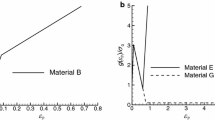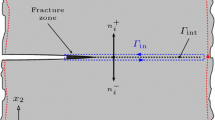Abstract
Transient creep crack growth due to grain boundary cavitation, and under plane strain and small scale creep conditions, is investigated. Full account is taken of the finite geometry changes accompanying crack tip blunting and the material is characterized as an elastic-power law creeping solid with an additional contribution to the creep rate arising from a given density of cavitating grain boundary facets. All voids are assumed present from the outset, distributed on a given density of cavitating grain boundary facets. Our analyses show the competing effects of stress relaxation due to creep, diffusion and crack tip blunting, and the stress increase due to crack growth. Another outcome of our analyses is the crack growth rate under various conditions of loading and for various values of material properties and for various characterizations of the failure process. Prior to crack growth, Hutchinson-Rice-Rosengren type singular fields dominate over the crack tip region, outside of a finite strain zone that has dimensions of the order of the crack opening displacement. These singular fields scale with the path integral C(t), which to a good approximation decays as K I 2/t, with t being the elapsed time since load application and K Ithe imposed stress intensity factor. When the crack growth rate is faster than the growth rate of the creep zone, our finite element results show that Hui-Riedel singular fields dominate over the crack tip region and the magnitude of the Hui-Riedel fields scales with the crack growth rate. For a crack that grows more slowly than the creep zone, Hutchinson-Rice-Rosengren type fields dominate over the crack tip region. In these circumstances, the crack growth rate is found to scale as C(t) to a power. Regardless of which of the two singular fields dominates for the growing crack, finite strain effects are found to be significant over a size scale of the order of the crack opening displacement at crack growth initiation. The effect of increased mesh refinement is also considered and very little mesh dependence is found.
Résumé
On étudie la croissance d'une fissure en fluage transitoire, associée à la cavitation aux frontières des grains, sous des conditions d'état plan de déformation et de fluage à petite échelle. On tient compte des modifications finies de géométrie accompagnant l'arrondisement de l'extrémité de la fissure, et le matériau suit une loi de fluage elasto-parabolique, avec une contribution additionnelle à la vitesse de fluage venant d'une densité donnée de facettes de joints de grains comportant de la cavitation. On suppose que toutes les cavités sont présentes dès le début, et qu'elles sont distribuées selon une densité déterminée de ces facettes. L'analyse montre les effets rivaux d'une relaxation des contraintes associée au fluage, à la diffusion et à l'arrondisement des extrémités de fissure, et d'une augmentation de contraintes due à la croissance de fissure. Un autre résultat de l'analyse est l'établissement de la vitesse de croissance de la fissure sous diverses conditions de mise en charge, pour diverses valeurs des propriétés du matériau, et pour divers modes de caractérisation du processus de rupture. Avant croissance de la fissure, ce sont des champs singuliers de type Hutchinson-Rice-Rosengren (HDR) qui prédominent sur la région de l'extrémité de la fissure, à l'extérieur d'une zone de déformations finies dont la taille est de l'ordre de grandeur du COD. Ces champs singulier sont proportionnels à l'intégrale de parcours C(t) laquelle, avec une bonne approximation, s'atténue en fonction de K I 2/t, où t est le temps qui s'est écoulé depuis la mise en charge et K Ile facteur d'intensité de contraintes imposés. Lorsque la vitesse de croissance de la fissure dépasse la vitesse de croissance de la zone en fluage, les résultats de l'analyse par éléments finis montre que ce sont les champs singuliers de Hui-Riedel qui prédominent sur la zone de l'extrémité de la fissure, et que l'amplitude de ces champs est proportionnelle à la vitesse de croissance de la fissure. Pour une fissure qui croit moins vite que la vitesse de fluage, es champs de type HRR sont prédominants et on trouve que la vitesse de croissance de la fissure est proportionelle C(t) à une certaine puissance. Quel que soit le type de champs singulier qui détermine la croissance de la fissure, on trouve que les effets de déformation finies sont significatifs sur une échelle de dimension de l'ordre du COD à l'amorçage de la fissuration. On considère également l'effet d'un affinage plus important du réseau, et l'on trouve me très faible dépendance par rapport à ce paramètre.
Similar content being viewed by others
References
J.D. Landes and J.A. Begley, in Mechanics of Crack Growth, ASTM STP 590, American Society for Testing and Materials, Philadelphia (1976) 128–148.
K.M. Nikbin, G.A. Webster and C.E. Turner, in Cracks and Fracture, ASTM STP 601, American Society for Testing and Materials, Philadelphia (1976) 47–62.
K. Ohji, K. Ogura and Y. Katada, “Creep Crack Propagation Rate in SUS 304 Stainless Steel and Interpretation in terms of Modified J Integral”, Preprint of the 25th Annual Meeting of the Society of Materials Science, Japan (1976) 19–20.
K. Sadananda and P. Shahinian, Metallurgical Transactions 8A (1977) 439–449.
R. Koterazawa and T. Mori, Journal of Engineering Materials and Technology 99 (1977) 298–305.
S. Taira, R. Ohtani and T. Kitamura, Journal of Engineering Materials and Technology 101 (1979) 154–161.
K. Ohji, K. Ogura and S. Kubo, Journal of Society of Material Science (Japan) 29 (1980) 465–471.
A. Saxena, in Fracture Mechanics: Twelfth Conference, ASTM STP 700, American Society for Testing and Materials, Philadelphia (1980) 131–151.
H. Riedel and W. Wagner, in Advances in Fracture Research '84-Proceedings of ICF6, Vol. 3, Pergamon Press, Oxford (1984) 2199–2206.
H. Riedel and V. Detampel, International Journal of Fracture 33 (1987) 239–262.
J.W. Hutchinson, Journal of Applied Mechanics 50 (1983) 1042–1051.
A. Saxena, in Fracture Mechanics: Seventeenth Volume, ASTM STP 905, American Society for Testing and Materials, Philadelphia (1986) 185–201.
V. Tvergaard, Acta Metallurgica 32 (1984) 1977–1990.
V. Tvergaard, Journal of the Mechanics and Physics of Solids 32 (1984) 373–393.
J.W. Hutchinson, Acta Metallurgica 31 (1983) 1079–1088.
V. Tvergaard, International Journal of Fracture 31 (1986) 183–209.
V. Tvergaard, Mechanics of Materials 4 (1985) 181–196.
D.R. Hayhurst, P.R. Brown and C.J. Morrison, Philosophical Transactions of the Royal Society of London, A 311 (1984) 131–158.
H. Riedel, Fracture of High Temperatures, Springer-Verlag Berlin, Heidelberg (1987).
D.S. Wilkinson and V. Vitek, Acta Metallurgica 30 (1982) 1723–1732.
J.L. Bassani, in Creep and Fracture of Engineering Materials and Structures, Pineridge Press (1981) 329–344.
H. Riedel and J.R. Rice, in Fracture Mechanics: Twelfth Conference, ASTM STP 700, American Society for Testing and Materials, Philadelphia (1980) 112–130.
J.L. Bassani and F.A. McClintock, International Journal of Solids and Structures 17 (1981) 467–476.
K. Koterazawa and Y. Iwata, Journal of Engineering Materials and Technology 98 (1976) 296–304.
C.Y. Hui and H. Riedel, International Journal of Fracture 17 (1981) 409–425.
J.W. Hutchinson, Journal of the Mechanics and Physics of Solids 16 (1968) 13–31.
J.R. Rice and G.F. Rosengren, Journal of Mechanics and Physics of Solids 16 (1968) 1–12.
C.F. Shih, Tables of Hutchinson-Rice-Rosengren Singular Field Quantities, Report MRL E-147, Materials Research Laboratory, Brown University, Providence (1983).
F.Z. Li, A. Needleman and C.F. Shih, International Journal of Fracture 36 (1988) 163–186.
D.E. Hawk and J.L. Bassani, Journal of the Mechanics and Physics of Solids 34 (1986) 191–212.
A.E. Green and W. Zerna, Theoretical Elasticity, 2nd ed., Oxford University Press, Oxford (1968).
B. Budiansky, in Problems of Hydrodynamics and Continuum Mechanics, SIAM, Philadelphia (1969) 77–83.
B.F. Dyson, Metal Science 10 (1976) 349–353.
J.R. Rice, Acta Metallurgica 29 (1981) 675–681.
A. Needleman and J.R. Rice, Acta Metallurgica 28 (1980) 1315–1332.
T.-L. Sham and A. Needleman, Acta Metallurgica 31 (1983) 919–926.
M.Y. He and J.W. Hutchinson, Journal of Applied Mechanics 48 (1981) 830–840.
D. Pierce, C.F. Shih and A. Needleman, Computers and Structures 18 (1984) 875–887.
A. Needleman, in Plasticity of Metals at Finite Strain: Theory, Computation and Experiment, E.H. Lee and R.L. Mallett (eds.), Stanford University, Stanford CA (1982) 387–436.
J.R. Rice, Journal of Applied Mechanics 35 (1968) 379–386.
N. Aravas and R.M. McMeeking, Journal of the Mechanics and Physics of Solids 35 (1985) 25–49.
A. Needleman and V. Tvergaard, Journal of the Mechanics and Physics of Solids 35 (1987) 151–183.
V. Tvergaard, Journal of the Mechanics and Physics of Solids 30 (1982) 399–425.
J.L. Bassani, D.E. Hawk and A. Saxena, “Evaluation of the C tParameter for Characterizing Creep Crack Growth Rate in the Transient Regime”, ASTM STP, to be published.
C.Y. Hui and V. Banthia, International Journal of Fracture 25 (1984) 53–67.
C.Y. Hui, International Journal of Solids and Structures 22 (1986) 357–372.
J.L. Bassani, D.E. Hawk and F.H. Wu, “Crack Growth in Small-Scale-Creep”, to be published.
A. Saxena, “Mechanics and Mechanisms of Creep Crack Growth”, in Fracture Mechanics: Microstructure and Micromechanisms, American Society of Metals, to be published.
F.H. Wu, J.L. Bassani and V. Vitek, Journal of the Mechanics and Physics of Solids 34 (1986) 455–475.
Author information
Authors and Affiliations
Rights and permissions
About this article
Cite this article
Li, F.Z., Needleman, A. & Shih, C.F. Creep crack growth by grain boundary cavitation: crack tip fields and crack growth rates under transient conditions. Int J Fract 38, 241–273 (1988). https://doi.org/10.1007/BF00019803
Received:
Accepted:
Issue Date:
DOI: https://doi.org/10.1007/BF00019803




